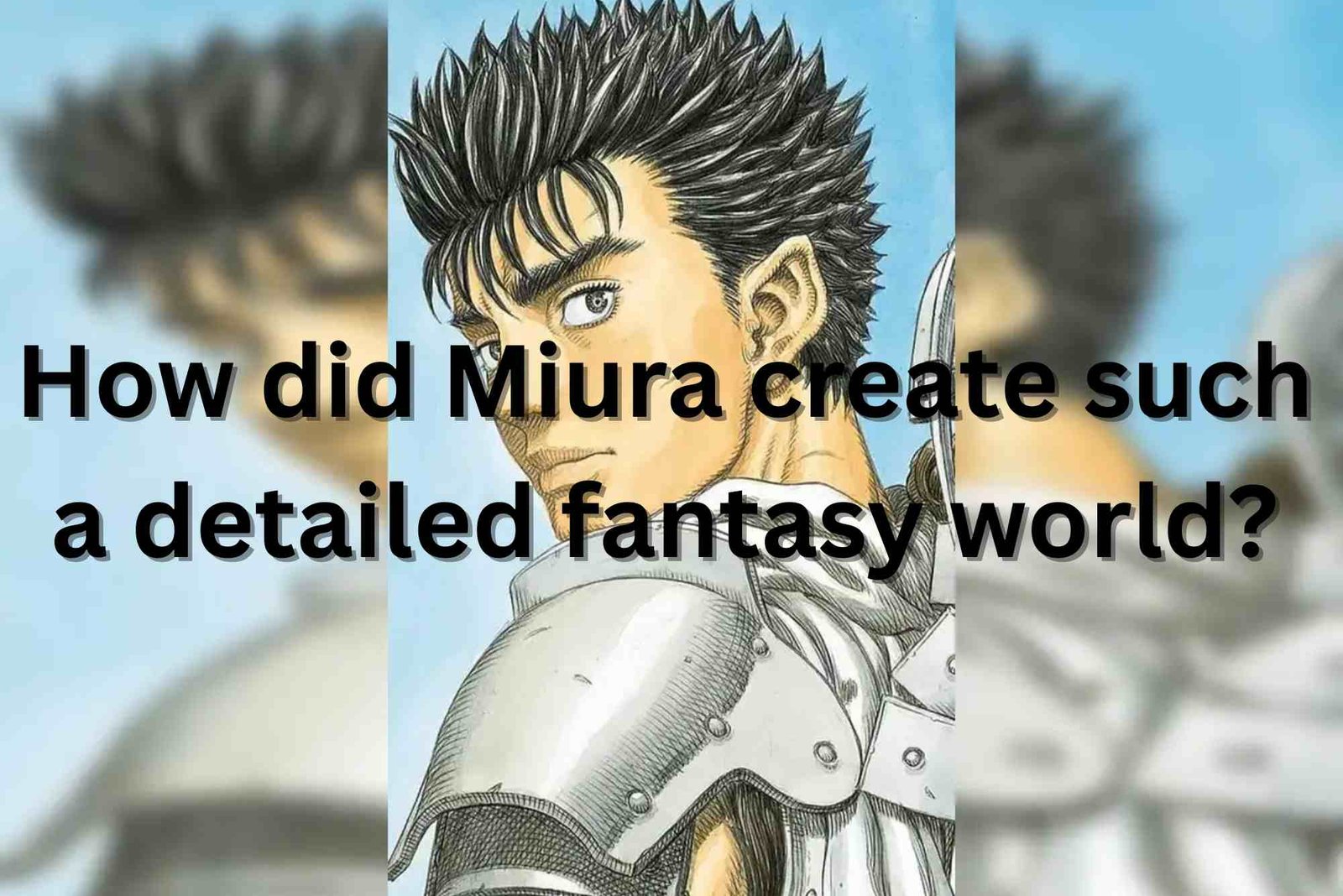The intricate and immersive world of Berserk, crafted by the legendary mangaka Kentaro Miura, stands as a pinnacle of fantasy storytelling. Since its debut in 1989, Berserk has captivated readers with its dark, richly detailed universe, complex characters, and hauntingly beautiful art. But how did Kentaro Miura, a singular creative force, build such a vivid and believable fantasy world? This article explores the techniques, inspirations, and meticulous craftsmanship behind the creation of Berserk’s unforgettable world.
The Foundations of Berserk’s Worldbuilding
Creating a fantasy world that feels authentic requires a delicate balance of imagination, research, and narrative cohesion. Kentaro Miura’s approach to worldbuilding in Berserk is a masterclass in blending historical influences, mythological depth, and psychological realism. His world, often described as a dark fantasy masterpiece, feels alive because of the care he poured into its every facet.
Drawing from Historical Inspirations
One of the cornerstones of Berserk’s world is its grounding in real-world history, particularly the European Middle Ages. Miura drew heavily from medieval aesthetics, architecture, and societal structures to shape the world of Midland and its surrounding kingdoms. The gritty realism of castle designs, armor, and weaponry reflects a deep understanding of historical contexts, making the world tangible to readers.
Miura’s attention to historical detail is evident in the depiction of battles, where knights wield period-accurate weapons like longswords and poleaxes. The feudal hierarchies in Berserk, with kings, nobles, and mercenaries, mirror the political dynamics of medieval Europe. By rooting his fantasy in a familiar historical framework, Miura gave readers a foundation to connect with the story, even as he introduced fantastical elements like demons and apostles.
Weaving Mythology and Folklore
Beyond historical influences, Berserk’s world is steeped in mythology and folklore, giving it a timeless, almost archetypal quality. Miura incorporated elements from various mythologies, including Christian, Norse, and Eastern traditions, to craft a cosmology that feels both familiar and otherworldly. The God Hand, a group of demonic beings central to the story, draws inspiration from cosmic horror and religious iconography, evoking a sense of awe and dread.
The interplay between fate and free will, a recurring theme in Berserk, is reminiscent of ancient myths where mortals grapple with divine forces. Miura’s use of archetypes—such as the cursed warrior (Guts) or the tragic hero (Griffith)—adds layers of depth, making the world feel like a living myth. This mythological framework allows readers to engage with Berserk on a philosophical level, pondering questions of destiny, sacrifice, and humanity.
Kentaro Miura’s Artistic Mastery
While the narrative foundations of Berserk are compelling, Miura’s artistry is what truly brings the world to life. His intricate illustrations are not just visually stunning but also integral to the storytelling and worldbuilding process.
The Power of Detailed Artwork
Kentaro Miura’s artwork is renowned for its meticulous detail, from the texture of a character’s armor to the sprawling landscapes of Midland. Every panel in Berserk is a testament to his dedication to visual storytelling. Whether it’s the grotesque design of an apostle or the haunting beauty of a moonlit battlefield, Miura’s art immerses readers in the world.
This level of detail serves a dual purpose: it enhances the aesthetic appeal and reinforces the world’s realism. For example, the depiction of a bustling medieval marketplace, complete with merchants, livestock, and weathered cobblestone streets, makes Midland feel like a place readers could step into. Miura’s ability to balance beauty and horror in his art creates a visceral experience that lingers long after the page is turned.
Visual Storytelling and Atmosphere
Miura’s art does more than depict; it sets the tone and atmosphere of Berserk’s world. The contrast between light and shadow, a hallmark of his style, mirrors the story’s themes of hope and despair. For instance, the Golden Age arc, one of the most beloved storylines in Berserk, uses warm, golden hues to evoke a sense of camaraderie and ambition, only to plunge into darkness as tragedy unfolds.
This visual storytelling extends to character design. Guts, the Black Swordsman, is visually imposing, with his massive sword and scarred body reflecting his inner turmoil. Similarly, the ethereal yet sinister appearance of the God Hand underscores their otherworldly power. Through these visual cues, Miura ensures that every element of Berserk’s world contributes to its emotional and narrative depth.
Crafting Complex Characters
A detailed fantasy world is only as compelling as the characters who inhabit it. Miura’s ability to create multifaceted, relatable characters is a key reason Berserk resonates with readers.
Guts: The Heart of Berserk
Guts, the protagonist of Berserk, is one of the most iconic characters in manga history. His journey from a hardened mercenary to a man seeking redemption is the emotional core of the story. Miura crafted Guts with a blend of stoic resilience and vulnerability, making him a relatable figure despite his larger-than-life presence.
Guts’ backstory, revealed through flashbacks, grounds his character in the world’s harsh realities. Born from a corpse and raised in a brutal mercenary camp, Guts embodies the struggle for survival that defines Berserk’s world. His relationships, particularly with Griffith and Casca, add layers of complexity, showing how personal connections shape the world as much as grand events.
Supporting Characters and Their Roles
Miura’s supporting cast is equally well-developed, each character contributing to the world’s richness. Griffith, the ambitious leader of the Band of the Hawk, is a study in charisma and tragedy, his choices reverberating across the entire narrative. Casca, a fierce warrior with a tragic arc, adds emotional weight and highlights the world’s gendered dynamics.
Even secondary characters, like the members of the Band of the Hawk or the mysterious Skull Knight, are given distinct personalities and motivations. This attention to character development ensures that Berserk’s world feels populated by real people, not just archetypes or plot devices.
Themes That Anchor the World
The depth of Berserk’s world is not just in its visuals or characters but in the themes that permeate the story. Miura used Berserk to explore profound questions about humanity, morality, and existence, making the world feel meaningful and cohesive.
The Struggle Between Fate and Free Will
A central theme in Berserk is the tension between fate and free will. The concept of causality, embodied by the God Hand and the mysterious entity known as the Idea of Evil, suggests that the world operates under a predetermined cosmic order. Yet, Guts’ relentless defiance of his supposed fate challenges this notion, creating a philosophical undercurrent that elevates the story.
This theme is woven into the world’s lore, from the prophecies that guide Griffith’s rise to the cursed brand that marks Guts for sacrifice. By exploring these ideas, Miura gives Berserk a sense of purpose, making its world more than just a backdrop for action.
The Duality of Good and Evil
Berserk’s world is morally ambiguous, with no clear line between good and evil. The apostles, demonic beings who were once human, embody this duality, as their monstrous forms stem from their own desires and choices. Similarly, Griffith’s transformation from a charismatic leader to a godlike entity raises questions about ambition and morality.
This moral complexity makes the world feel authentic, as it mirrors the ambiguities of real life. Miura’s refusal to simplify good and evil ensures that readers are constantly challenged to question their assumptions, deepening their engagement with the story.
Miura’s Creative Process
Understanding how Kentaro Miura built Berserk’s world also requires looking at his creative process. Known for his perfectionism, Miura poured years into crafting each chapter, often taking breaks to ensure the quality of his work.
Research and Attention to Detail
Miura’s commitment to research was a driving force behind Berserk’s authenticity. He studied medieval history, art, and mythology to inform his worldbuilding, ensuring that every element, from clothing to architecture, felt plausible. This dedication is evident in the consistency of Berserk’s world, where even minor details align with the broader narrative.
Balancing Scope and Intimacy
One of Miura’s greatest strengths was his ability to balance the epic scope of Berserk’s world with intimate, character-driven moments. While the story spans kingdoms, wars, and cosmic battles, it never loses sight of the personal struggles of its characters. This balance keeps the world grounded, preventing it from feeling overwhelming or detached.
The Legacy of Berserk’s World
Kentaro Miura’s untimely passing in 2021 left Berserk unfinished, but his world continues to inspire readers and creators alike. The manga’s influence can be seen in countless works of fantasy, from video games like Dark Souls to other manga and anime. Miura’s ability to create a world that is both expansive and deeply personal has cemented Berserk as a timeless masterpiece.
Inspiring Future Creators
Berserk’s worldbuilding has set a high standard for fantasy storytelling. Its blend of historical realism, mythological depth, and emotional resonance offers a blueprint for creators looking to craft immersive worlds. Miura’s legacy lies not just in the story he told but in the way he showed that every detail, no matter how small, matters in bringing a world to life.
The Enduring Appeal of Berserk
For fans, Berserk’s world is more than just a setting—it’s a place to explore the human condition. Its dark beauty, complex characters, and philosophical depth make it a world that readers return to time and again. Even as the story remains incomplete, its impact endures, a testament to Miura’s unparalleled vision.
Conclusion
Kentaro Miura’s creation of Berserk’s detailed fantasy world is a triumph of imagination, research, and artistry. By grounding his story in historical and mythological influences, crafting compelling characters, and exploring profound themes, Miura built a world that feels alive and unforgettable. His meticulous artwork and thoughtful storytelling ensure that Berserk remains a benchmark for worldbuilding in fantasy. For readers and creators alike, Miura’s work is a reminder that a truly great fantasy world is one that resonates on both an epic and a deeply human level.






